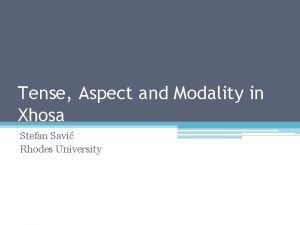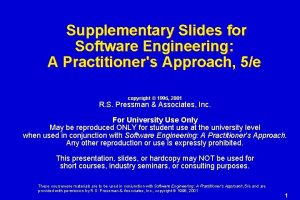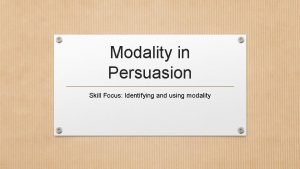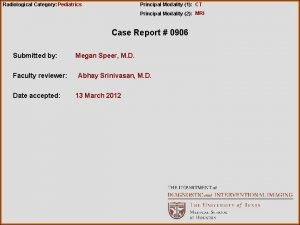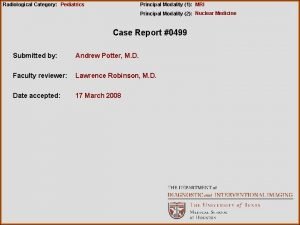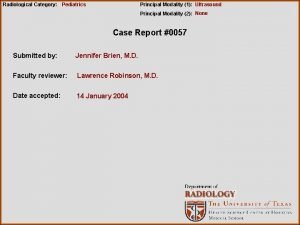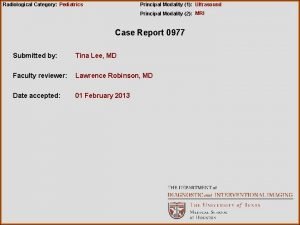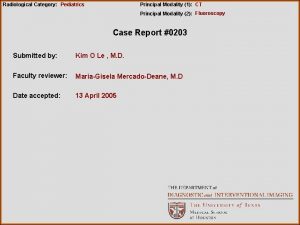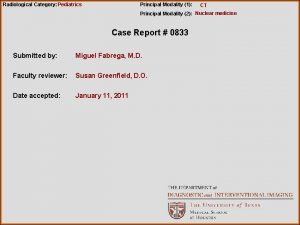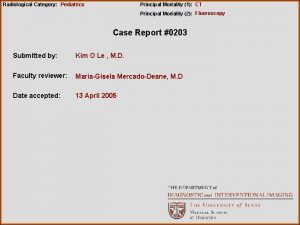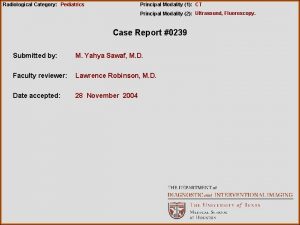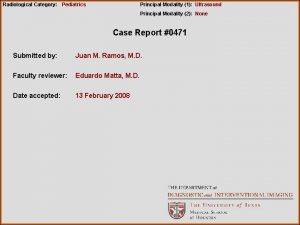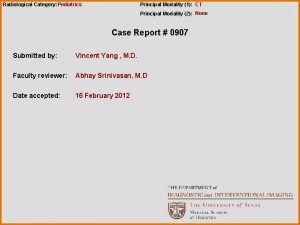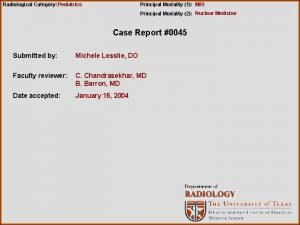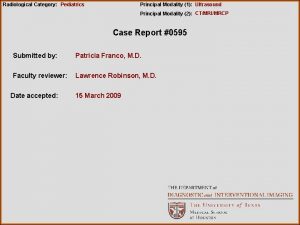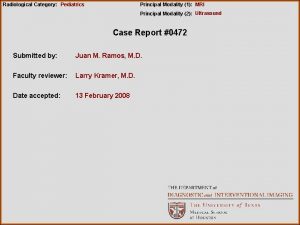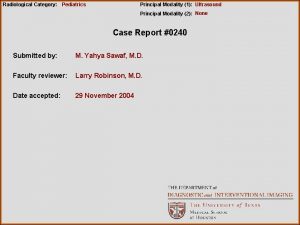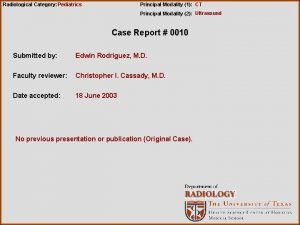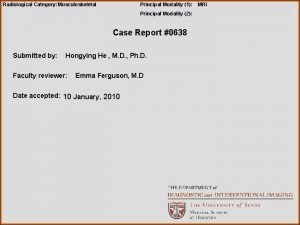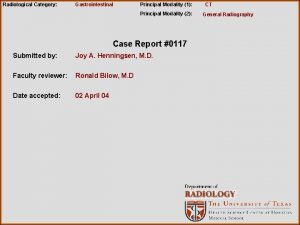Radiological Category Pediatrics Principal Modality 1 CT Principal






















- Slides: 22

Radiological Category: Pediatrics Principal Modality (1): CT Principal Modality (2): MRI Case Report #0207 Submitted by: Jin T. Kim, M. D. Faculty reviewer: Susan John, M. D Date accepted: 15 April 2005

Case History 10 -1/2 month old female who presents with 1 day history of fever to 102. 1, runny nose and cough for 1 week.

CXR PA

CXR Lateral

Contrast-enhanced CT chest: Image 1

Contrast-enhanced CT chest: Image 2

Barium Swallow

MRI Abdominal Axial SSH BH

MRI Abdominal Coronal SSH BH

MRI T 1 BB BH MS

MRI Abdominal Coronal SSH BH

Test Your Diagnosis Which one of the following is your choice for the appropriate diagnosis? After your selection, go to next page. • Sequestration • Enteric Cyst • Bronchogenic Cyst • Congenital Cystic Adenomatoid Malformation (CCAM) • Neurogenic Tumor • Round Pneumonia

Findings and Differentials Findings: - CXR PA and lateral: 2. 8 cm round opacity in right paravertebral region. - CT chest with contrast: Non-enhancing bilobular complex cystic lesion in the right posterior inferior mediastinum that displaces esophagus towards the left. 14 to 40 HU. - Barium swallow: Mass does not communicate freely with the esophagus. - MRI chest with and without contrast: Cystic lesion with internal septations without rim or mural enhancement. Lesion contacts the right hemidiaphragm medially, the lower thoracic vertebral bodies laterally, and the left atrium posteriorly. The posteromedial segment of the right lower lobe is displaced around the lesion. Differentials: • Bronchogenic cyst • Gastrointestinal duplication cyst

Discussion Chest masses in children are often clinically silent and are often discovered incidentally on radiographs obtained for respiratory infections. If the mass is critically located in the chest, it may present earlier with respiratory distress, stridor, or dysphagia. Infection or bleeding may cause the mass to become symptomatic. CT or MRI are often used to better define the soft tissue characteristics of the mass. Nuclear scintigraphy is seldom used, but may be helpful for lesions suspected of being thyroid in origin. In older children, the most common mediastinal mass is inflammatory lymphadenopathy. Thereafter, neurogenic tumors, lymphoma, and a variety of developmental masses and cysts make up the majority of mediastinal masses in childhood. In children, as in adults, mediastinal masses are classified on the basis of their location in the mediastinum. Posterior mediastinal lesions commonly are neurogenic in origin , such as neuroblastoma, neurenteric cysts, and intrathoracic meningocele. Pulmonary sequestration and congenital cysts may also occur posteriorly. Middle mediastinal lesions consist mainly of enlarged lymph nodes or developmental cysts. In the anterior mediastinum, tumors include teratomas, dermoids, thymomas, cystic hygromas, lymphomas, or thyroid tumor or cyst.

Discussion Pulmonary sequestration consists of aberrant lung tissue that 1) has no normal connection with the bronchial tree or with the pulmonary arteries; or 2) is supplied by a systemic artery that usually arises from the aorta. Sequestration is a congenital abnormality secondary to failure of obliteration of one of the systemic arterial connections to the base of the developing fetal lung. There are two types: intralobar and extralobar. Classically, sequestrations are located in the lower lobes. Contrast-enhanced CT or MRI show the abnormal systemic artery in the majority of cases. Failure to identify a systemic artery on CT or MR, however, does not exclude the diagnosis. Angiography will demonstrate the anomalous systemic vessel, but is seldom needed.

Discussion The esophagus is one of the most common sites of origin of gastrointestinal duplication cysts, comprising 15 -20% of all duplications. The cysts are probably the result of faulty recanalization of the esophagus early in fetal life. Esophageal duplications are usually located in the middle or posterior mediastinum, close to the esophagus. These cysts infrequently connect with the gastrointestinal tract. On radiographs, duplication cysts appear as round or oval fluid-filled masses, displacing the esophagus and other adjacent structures. Histologically, neurenteric or enteric cysts are lined with esophageal, gastric, or intestinal epithelium. When gastric mucosa lines the cyst, peptic ulceration may occur with erosion in to the lung parenchyma, bronchus or esophagus. The gastric mucosa can be identified with nuclear scintigraphy using technetium-99 m studies.

Discussion Bronchogenic cysts are the most commonly encountered cysts in the chest and represent bronchopulmonary foregut malformations resulting from abnormal budding or branching of the tracheobronchial tree during embryologic development. The cysts are lined by pseudostratified ciliated columnar epithelium, and they usually contain smooth muscle, mucus glands, and cartilage. They may occur in either the mediastinum or, less commonly, in the lung. Many occur around the carina, upper trachea, or along the bronchi. Subcarinal cysts may result in life-threatening airway compromise. Other cysts may be asymptomatic. Cyst-related complications such as infection, rupture, bleeding, and compression are common and a risk of malignant degeneration also exists. The long-term prognosis of asymptomatic bronchogenic cysts is unpredictable, and the potential risks are life threatening. Many surgeons support surgical resection. Most bronchogenic cysts are fluid-filled and do not connect with the tracheobronchial tree. Radiographically, these cysts appear as smooth, round, or oval masses in the chest. CT demonstrates a well-defined mass that may have variable CT densities depending on the nature of the fluid content. Mucus or calcium within the cyst can cause the cyst to have attenuation greater than water. On MRI, the lesions have the typical appearance of cysts with long T 1 and T 2 values. Cysts that contain mucus may have high signal intensity on T 1 -weighted images. Contrast enhancement is usually absent, unless the cyst is infected.

Discussion Congenital cystic adenomatoid malformation of the lung is an uncommon lesion that usually is detected prenatally or in infancy. Symptomatic lesions usually cause respiratory distress secondary to mass effect that compromises ventilation. Type I CCAM is the most common type and is characterized by single or multiple large cysts of varying size measuring more than 2 cm in diameter. Type II consists of multiple small cysts of more uniform size not exceeding 2 cm in diameter. Type III consists of large, bulky, solid-appearing lesions that contain multiple microscopic-sized cysts. The cysts of CCAM are filled with fluid during the first day of life, but the cysts gradually become air-filled. Chest radiographs and CT may demonstrate the multicystic nature of the mass.

Discussion Posterior mediastinal tumors are usually neurogenic in origin. The neuroblastomaganglioneuroma complex is most common (90% of cases), although neurofibroma may also occur. These tumors are predominantly solid and may contain calcifications. Rib erosion and spreading are common and may be visible on radiographs. CT or MRI is used to determine extent of tumor and whethere is any intraspinal extension (“dumbbell” tumor). Intervertebral foramen enlargement, pedicular flattening, posterior vertebral flattening, spinal canal widening, and localized kyphosis or scoliosis are radiographic findings that indicate intraspinal extension.

Discussion Round pneumonia is a radiographic presentation of pneumonia that occurs more commonly in children. The pneumonia presents as a round mass-like opacity, usually caused by Streptococcus pneumoniae. The round shape is caused by centrifugal spread of the rapidly expanding exudate by way of the pores of Kohn and canals of Lambert from a single primary focus in the lung.

Diagnosis Bronchogenic cyst was confirmed on pathologic specimen obtained during thorascopic excision.

References Berrocal T, Madrid C, Novo S, Gutierrez J, Arjonilla A, Gomez-Leon N, congenital Anomalies of the Tracheobronchial Tree, Lung, and Mediastinum: Embryology, Radiology, and Pathology. Radiographics 2003; 24: e 17. Berrocal T, Torres I, Gutierrez J, et al. Congenital anomalies of the upper gastrointestinal tract. Radiographics 1999; 19: 855 -872. Brant WE, Helms CA, Fundamentals of Diagnostic Radiology, 2 nd edition, 1999 Williams and Wilkins, Philadephia. Cataletto ME, Bronchogenic Cyst, www. e. Medicine. com, March 4, 2004. Mc. Loud TC, Thoracic Radiology: The Requisites, 1998 Mosby, St. Louis. Swischuk LE, Imaging of the Newborn, Infant, and Young Child, 5 th edition, 2004 Lippincott Williams and Wilkins, Philadelphia.
 Pa erate
Pa erate National radiological emergency preparedness conference
National radiological emergency preparedness conference Radiological dispersal device
Radiological dispersal device Tennessee division of radiological health
Tennessee division of radiological health Center for devices and radiological health
Center for devices and radiological health Cardinality and modality
Cardinality and modality Cardinality and modality
Cardinality and modality Tom arbuthnot
Tom arbuthnot Epistemic modality
Epistemic modality Birads scoring
Birads scoring What is modality in statistics
What is modality in statistics Modality
Modality Modality in software engineering
Modality in software engineering Entity class in software engineering
Entity class in software engineering Deontic and epistemic modality exercises
Deontic and epistemic modality exercises Modality in software engineering
Modality in software engineering Cardinality and modality in database
Cardinality and modality in database Modality
Modality High modality definition
High modality definition Pacs modality workstation
Pacs modality workstation Diplode
Diplode Exteroceptors
Exteroceptors Sodality vs modality
Sodality vs modality











